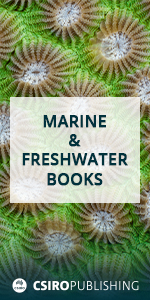Fish daily age information provides insight into growth, phenology, recruitment and survival, but is rarely incorporated into fisheries management because data collection is laborious. We tested Fourier transform–near-infrared (FT-NIR) spectroscopy as a rapid method to determine daily age from otoliths of an important commercial species, walleye pollock (Gadus chalcogrammus). Results indicated that FT-NIR spectroscopy may provide a valuable tool to collect daily age information for research and management.

Marine and Freshwater Research
Volume 76 Number 10 2025
The Blue Peacebuilding Scorecard introduces an innovative method for assessing how governments are integrating Indigenous rights and interests into ocean management. This research debuts the BPS with case studies from Australia, Canada and New Zealand. The authors spotlight programs that other nations can learn from to reduce conflict, advance reconciliation and work towards a sustainable ocean future.
This article belongs to the collection: Science in Sea Country.
MF24180 Abstract | MF24180 Full Text | MF24180PDF (4.5 MB) Open Access Article
There is widespread contamination of our oceans with plastic waste, dominated by MPs and NPs. Crustaceans, such as shrimp, exhibit omnivorous feeding habits, consuming all available substances in their environment, including MPs from water, sediment and prey. The detrimental effects of MPs and NPs on crustaceans are multifaceted, encompassing metabolic and biochemical disturbances, alterations in feeding behaviours, histological anomalies, organ dysfunctions, synergistic interactions with heavy metals, reproductive malformations, dysregulated pattern of gene expression, elevated oxidative stress responses and diminished survival rates.
Stingray City, Cayman Islands, is one of the most famous marine life interaction sites in the world, where an aggregation of stingrays are regularly fed by and interact with humans. During the COVID-19 pandemic, feeding of stingrays ceased and tourism operations at the site shut down. During this time, the size and composition of the stingray aggregation changed dramatically and even following resumption of tourism activities, the aggregation remained altered from pre-pandemic conditions. This study has illustrated the large-scale effects that human activities may have on wildlife tourism.
This study tracks significant changes in seagrass meadows across Australia’s Eastern Banks (Moreton Bay) from 2011 to 2024, by using nearly 50,000 photo samples. Results showed declines in overall seagrass coverage across three banks, with Oceana serrulata replacing Zostera muelleri as the dominant species in some areas. These ecosystem shifts appear linked to flood events and changing water quality, highlighting the vulnerability of these ecosystems to environmental disturbances, and emphasising the need for enhanced monitoring and management.
MF25049 Abstract | MF25049 Full Text | MF25049PDF (2.1 MB) | MF25049Supplementary Material (559 KB) Open Access Article
Tawny nurse sharks (Nebrius ferrugineus) are caught incidentally by the Queensland Shark Control Program (QSCP) using baited drumlines and large-mesh nets. This study found that the at-vessel mortality (AVM) of N. ferrugineus was 5.95 and 30.1% for those animals caught on drumlines and in nets respectively. As such, the QSCP poses low risk to the N. ferrugineus population in Queensland.
MF25015 Abstract | MF25015 Full Text | MF25015PDF (670 KB) | MF25015Supplementary Material (440 KB) Open Access Article




